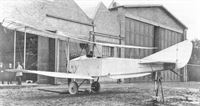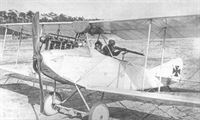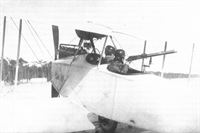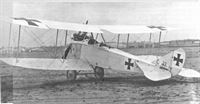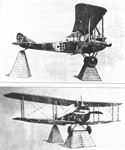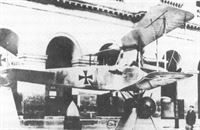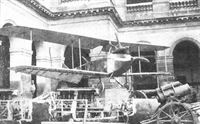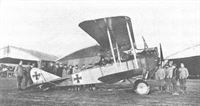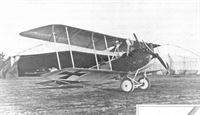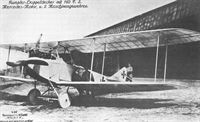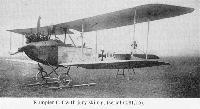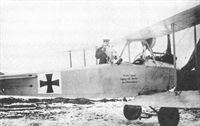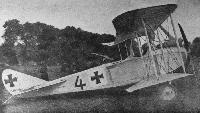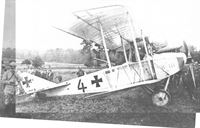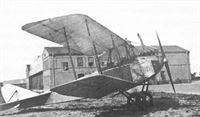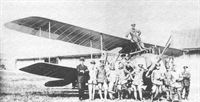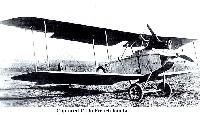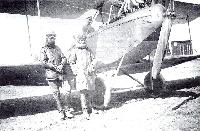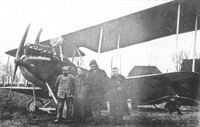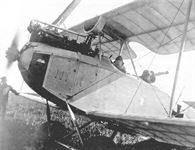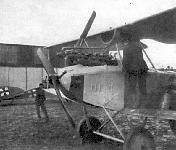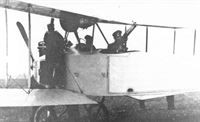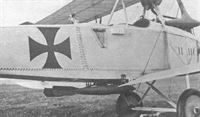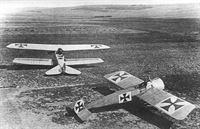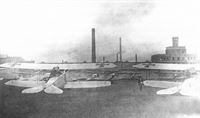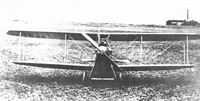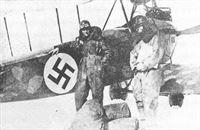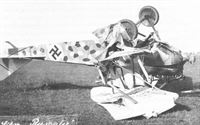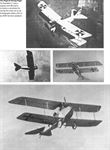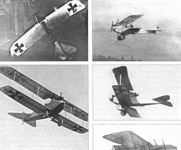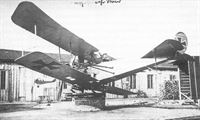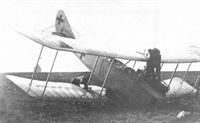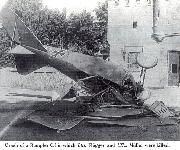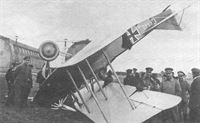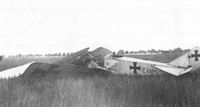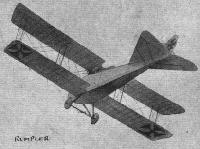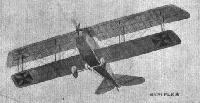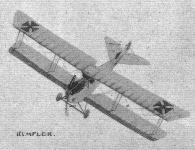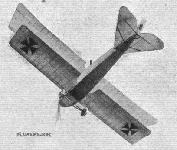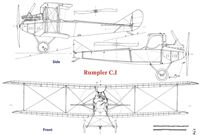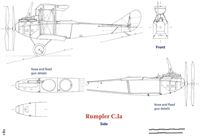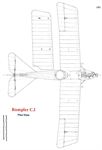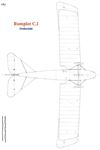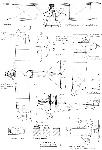
Описание
Страна: Германия
Год: 1914
Two-seat general duties
Варианты
- Rumpler - C.I/C.Ia - 1914 - Германия
- Rumpler - 6B1/6B2 - 1916 - Германия
- Rumpler - C.III/C.V - 1916 - Германия
- Rumpler - C.IV - 1916 - Германия
- Rumpler - C.VII / Rubild Mb - 1917 - Германия
- Rumpler - C.VIII - 1917 - Германия
- В.Кондратьев Самолеты первой мировой войны
- А.Александров, Г.Петров Крылатые пленники России
- O.Thetford, P.Gray German Aircraft of the First World War (Putnam)
- J.Herris Rumpler Aircraft of WWI (A Centennial Perspective on Great War Airplanes 11)
- M.Dusing Germania Flugzeugwerke and its Aircraft (A Centennial Perspective on Great War Airplanes 41)
- C.Owers, J.Herris Hannover Aircraft of WWI (A Centennial Perspective on Great War Airplanes 46)
- M.Dusing German Aviation Industry in WWI. Volume 1 (A Centennial Perspective on Great War Airplanes 84)
- M.Dusing German Aviation Industry in WWI. Volume 2 (A Centennial Perspective on Great War Airplanes 85)
-
J.Herris - Rumpler Aircraft of WWI /Centennial Perspective/ (11)
Rumpler C.I C.1064/15
-
J.Herris - Rumpler Aircraft of WWI /Centennial Perspective/ (11)
Rumpler C.I C.4535/15 of Kasta 20
-
J.Herris - Rumpler Aircraft of WWI /Centennial Perspective/ (11)
Rumpler C.I C4654/15
-
J.Herris - Rumpler Aircraft of WWI /Centennial Perspective/ (11)
Rumpler C.I C.4607/16 in Polish service postwar
-
J.Herris - Rumpler Aircraft of WWI /Centennial Perspective/ (11)
Rumpler C.I of Kasta 1
-
J.Herris - Rumpler Aircraft of WWI /Centennial Perspective/ (11)
Rumpler C.I of Kasta 1
-
J.Herris - Rumpler Aircraft of WWI /Centennial Perspective/ (11)
Rumpler C.I of Kasta 2
-
J.Herris - Rumpler Aircraft of WWI /Centennial Perspective/ (11)
Rumpler C.I of Kasta 4
-
J.Herris - Development of German Warplanes in WWI /Centennial Perspective/ (1)
Rumpler C.I; many early C-types were painted light blue or gray overall.
-
J.Herris - Rumpler Aircraft of WWI /Centennial Perspective/ (11)
Rumpler C.I of Schusta 2
-
J.Herris - Rumpler Aircraft of WWI /Centennial Perspective/ (11)
The Rumpler 5A1 was the prototype Rumpler C.I. The slightly modified production Rumpler C.I had the factory designation Rumpler model 5A2. The rudder and fin of the production aircraft was enlarged slightly from the 5A1. The aircraft is seen in its initial form without markings at the time of initial test flights in June 1915 in front of the Rumpler factory at Johannisthal.
-
J.Herris - Rumpler Aircraft of WWI /Centennial Perspective/ (11)
The Rumpler C.I prototype after national insignia were applied but before the pilot's fixed, synchronized gun was fitted. A spherical gravity tank has been added below the center section.
-
J.Herris - Rumpler Aircraft of WWI /Centennial Perspective/ (11)
The Rumpler C.I prototype before the pilot's fixed, synchronized gun was fitted. The spherical gravity tank added below the center section is clearly visible. The claw brake is fitted to the axle.
-
J.Herris - Rumpler Aircraft of WWI /Centennial Perspective/ (11)
The Rumpler C.I prototype after national insignia were applied but before the pilot's fixed, synchronized gun was fitted. The gunner is demonstrating his wide field of fire with a dummy wooden gun.
-
J.Herris - Rumpler Aircraft of WWI /Centennial Perspective/ (11)
The Rumpler C.I prototype before the pilot's fixed, synchronized gun was fitted. The spherical gravity tank added below the center section is clearly visible. The claw brake is fitted to the axle.
-
J.Herris - Rumpler Aircraft of WWI /Centennial Perspective/ (11)
Rumpler C.I 53/15 was a very early production aircraft, powered by a 160hp Mercedes D III. Armed with a fixed, pilot-aimed 7.9mm Spandau, along with the observer's 7.92mm Parabellum, the Rumpler C I was considered by many to be the best and most reliable of all C types produced. Top level speed of the machine was 94mph at sea level, while the service ceiling was around 16,600 feet. Normal range was given as 336 miles.
-
J.Herris - Rumpler Aircraft of WWI /Centennial Perspective/ (11)
Rumpler C.I 393/15 was the very first production Rumpler C.I.
-
J.Herris - Rumpler Aircraft of WWI /Centennial Perspective/ (11)
Rumpler C.I 1851/15 was from the fourth production batch. These were the first Rumpler C.I aircraft built with a rotating turret for the gunner, something that all subsequent aircraft featured.
-
J.Herris - Rumpler Aircraft of WWI /Centennial Perspective/ (11)
This Rumpler C.I 1851/15 came down behind Allied lines and was captured.
-
J.Herris - Rumpler Aircraft of WWI /Centennial Perspective/ (11)
Rumpler C.I 1869/15 draws a crowd.
-
Сайт - Pilots-and-planes /WWW/
Rumpler C.I C.2642/15
-
J.Herris - Rumpler Aircraft of WWI /Centennial Perspective/ (11)
Captured Rumpler C.I 4525/15 on display in France.
-
J.Herris - Rumpler Aircraft of WWI /Centennial Perspective/ (11)
Captured Rumpler C.I 4525/15 on display in France.
-
J.Herris - Rumpler Aircraft of WWI /Centennial Perspective/ (11)
Captured Rumpler C.I on display in France.
-
J.Herris - Rumpler Aircraft of WWI /Centennial Perspective/ (11)
Rumpler C.I 4601/15 in pristine finish. The finish is not original so it has been recovered, probably after repair.
-
O.Thetford, P.Gray - German Aircraft of the First World War /Putnam/
Rumpler C I (serial C4652/15).
-
J.Herris - Rumpler Aircraft of WWI /Centennial Perspective/ (11)
Early production models of the Rumpler C.I were powered by the 160 hp Mercedes D.III, and immediately established themselves as reliable airplanes with good performance and handling qualities. Some later production C.Is had a 150 hp Benz Bz.III or 180 hp Argus As.III.The C.I was an excellent general purpose C-type that was popular with its crews.
-
Сайт - Pilots-and-planes /WWW/
Техник демонстрирует легкость фюзеляжа "Хальберштадта" D.II.
Halberstadt D.II(Han) 818/16. being admired by the men; the light weight is indicated by the man lifting the tail. The photos of 816/16 and 818/16 show the factory finish of Hannover-built Halberstadt D.ll fighters. Rumpler C.I 2623/16 and Rumpler G.II 122/15 are in the background.Другие самолёты на фотографии: Halberstadt D.II/D.III - Германия - 1916Rumpler G.I/G.II/G.III - Германия - 1915
-
J.Herris - Halberstadt Aircraft of WWI. Volume 2: CL.IV-CLS.I & Fighters /Centennial Perspective/ (45)
Halberstadt D.II(Han) 818/16 (work no. 141) was part of a batch of 30 Halberstadt D.II fighters built under license by Hannoveranner. The Hannover-built aircraft had two-color camouflage on the upper surfaces. The stenciled serial numbers in white on the rear fuselage are a key identifier of Hannover-built aircraft. Rumpler C.I 2623/16 is in the background. (Peter M. Grosz Collection/STDB)
Другие самолёты на фотографии: Halberstadt D.II/D.III - Германия - 1916
-
J.Herris - Albatros Aircraft of WWI. Volume 4: Fighters /Centennial Perspective/ (27)
Top: Albatros D.III 2051/16 in the middle and Rumpler C.I C.4633/15 at left. In the right background is the Albatros D.I fighter with skull and cross-bones insignia often flown by Prinz Friedrich Karl von Preussen, crown prince of Prussia.
Bottom: Manfred von Richthofen walks toward the photographer with a Albatros D.III 2051/16 behind him and Rumpler C.I C.4633/15 at left. In the right background is the Albatros D.I fighter with skull and cross-bones insignia often flown by Prinz Friedrich Karl von Preussen, crown prince of Prussia.Другие самолёты на фотографии: Albatros D.I/D.II - Германия - 1916Albatros D.III - Германия - 1916
-
J.Herris - Rumpler Aircraft of WWI /Centennial Perspective/ (11)
Rumpler C.I 1131/16 after being captured.
-
J.Herris - Rumpler Aircraft of WWI /Centennial Perspective/ (11)
Rumpler C.I 1131/16 in French hands.
-
M.Dusing - German Aviation Industry in WWI. Volume 2 /Centennial Perspective/ (85)
Rumpler C.I (5A2) (1915)
-
J.Herris - Rumpler Aircraft of WWI /Centennial Perspective/ (11)
Rumpler C.I 4660/16 was immortalized in Sanke card 439.
-
O.Thetford, P.Gray - German Aircraft of the First World War /Putnam/
Rumpler C I with jury ski rig, (serial 6081/16).
-
J.Herris - Rumpler Aircraft of WWI /Centennial Perspective/ (11)
Observer demonstrates his camera technique.
-
J.Herris - Rumpler Aircraft of WWI /Centennial Perspective/ (11)
Camouflaged Rumpler C.I assigned to Schusta 2.
-
Jane's All The World Aircraft 1919 /Jane's/
Side view of a Rumpler C.I type two-seat general-purpose biplane captured by the French. The C.I was an improved armed version of the B.I and was operational from 1915-17, then as a trainer. 160 hp Mercedes engine usually allowing 95 m.p.h.
-
J.Herris - Rumpler Aircraft of WWI /Centennial Perspective/ (11)
French soldiers inspect this captured Rumpler CI. By 1916 the type was an important general-purpose aircraft and was well liked by its crews. When eventually outclassed on the Western Front it went on to serve in other theatres.
-
J.Herris - Rumpler Aircraft of WWI /Centennial Perspective/ (11)
Rumpler C.I trainer, under the wing is a 1918 cross.
-
J.Herris - Rumpler Aircraft of WWI /Centennial Perspective/ (11)
A Rumpler C.I in training service in 1918 (per the national insignia style) is a backdrop for a unit photograph.
-
Сайт - Pilots-and-planes /WWW/
Rumpler C.I in Allied hands after capture.
-
J.Herris - Rumpler Aircraft of WWI /Centennial Perspective/ (11)
Rumpler and its aircrew; von Hackenberger at left.
-
J.Herris - Rumpler Aircraft of WWI /Centennial Perspective/ (11)
Rumpler C.I ready for its next flight.
-
J.Herris - Rumpler Aircraft of WWI /Centennial Perspective/ (11)
A Rumpler C.I in training service in 1918 (per the national insignia style) is a backdrop for a unit photograph.
-
M.Dusing - German Aviation Industry in WWI. Volume 1 /Centennial Perspective/ (84)
Proud crew of a frontline aircraft.
-
J.Herris - Rumpler Aircraft of WWI /Centennial Perspective/ (11)
Rumpler C.I ready to take off on another mission.
-
J.Herris - Rumpler Aircraft of WWI /Centennial Perspective/ (11)
Rumpler C.I serving with Feld-Flieger-Abteilung 32.
-
J.Herris - Rumpler Aircraft of WWI /Centennial Perspective/ (11)
Rumpler C.I observer demonstrates his weapon.
-
J.Herris - Weird Wings of WWI /Centennial Perspective/ (70)
The German Heinecke parachute under testing and in use.
-
J.Herris - Rumpler Aircraft of WWI /Centennial Perspective/ (11)
The Rumpler C.I soldiered on postwar. Willy Donner and others pose with a C.I in transport service.
-
J.Herris - Rumpler Aircraft of WWI /Centennial Perspective/ (11)
This closeup of a Rumpler C.I with cowling panel removed shows the pilot's fixed machine gun. The "H" with arrow added to the photo points to the 'Hebei', the lever arm of the synchronizing mechanism.
-
J.Herris - Rumpler Aircraft of WWI /Centennial Perspective/ (11)
Rumpler C.I with two 50 kg PwK bombs carried under the fuselage.
-
J.Herris, J.Scott - Fokker Aircraft of WWI. Vol.2: Eindeckers /Centennial Perspective/ (52)
A Fok. E.II/early E.III shares a field with a Rumpler C.I. (Peter M. Grosz collection/STDB)
Другие самолёты на фотографии: Fokker E.I / E.II / E.III / M.14 - Германия - 1914
-
J.Herris - Rumpler Aircraft of WWI /Centennial Perspective/ (11)
Rumpler C.Ia(Han) aircraft lined up outside the Hannover factory ready for delivery.
-
J.Herris - Rumpler Aircraft of WWI /Centennial Perspective/ (11)
Rumpler C.Ia(Han) at the Hannover factory.
-
M.Dusing - Germania Flugzeugwerke and Its Aircraft /Centennial Perspective/ (41)
Otto Onigkeit in front of a Rumpler C.Ia(Han) repaired by Germania. Only the version C.Ia with 180 hp Argus As.III engine (instead of the 160 hp Mercedes D.III) was built by the Hannoverian Wagon Factory. Volker Koos.
-
C.Owers, J.Herris - Hannover Aircraft of WWI /Centennial Perspective/ (46)
Rumpler C.Ia(Han) 4666/16 was from the first production batch of C.Ia aircraft built by Hannover. The C.Ia was powered by a 180 hp Argus As.III, giving it slightly greater speed at low level but poorer reliability and high-altitude performance than the 160 hp Mercedes D.III. All C.Ia aircraft were built by Hannover, the only C.I derivative Hannover built.
-
J.Herris - Rumpler Aircraft of WWI /Centennial Perspective/ (11)
Rumpler C.Ia(Han) showing the distinctive built-up fuselage for the observer's gun ring unique to Hannover.
-
J.Herris - Rumpler Aircraft of WWI /Centennial Perspective/ (11)
Rumpler C.Ia(Han) with the raised fuselage around the observer's gun ring unique to Hannover-built aircraft.The only license-built C.I aircraft used in combat were the C.Ia aircraft built by Hannover. All other license-built aircraft were intended as trainers.
-
J.Herris - Rumpler Aircraft of WWI /Centennial Perspective/ (11)
Another view of the Rumpler C.I under test with a 175 hp Rapp Rp.IIIa engine at Adlershof.
-
J.Herris - Rumpler Aircraft of WWI /Centennial Perspective/ (11)
Rumpler C.I under test with a 175 hp Rapp Rp.IIIa engine at Adlershof.
-
J.Herris - Rumpler Aircraft of WWI /Centennial Perspective/ (11)
Rumpler C.I(Habra) trainer. The bulge in the lower port wing is the housing for the compass.
-
J.Herris, J.Leckscheid - Fokker Aircraft of WWI. Vol.3: Early Biplane Fighters /Centennial Perspective/ (53)
Crash photos always provide interesting details. D.III 2953/16 was completely wrecked on 20 August 1917 by crashing into Rumpler C.I 6564/16. The late-production D.III features a thinly-applied streaked camouflage pattern, and the ailerons which were fitted to the final production batch are also in evidence.
Другие самолёты на фотографии: Fokker D.III / M.19 - Германия - 1916
-
M.Dusing - Germania Flugzeugwerke and Its Aircraft /Centennial Perspective/ (41)
100th Rumpler C.I(Germ) aeroplane, marked on the tip of engine cowling
-
M.Dusing - Germania Flugzeugwerke and Its Aircraft /Centennial Perspective/ (41)
The 100th licence-built Rumpler C.I(Germ), Germania Director Egwin Leiber stands in front the aircraft.
-
M.Dusing - Germania Flugzeugwerke and Its Aircraft /Centennial Perspective/ (41)
The 100th Rumpler C.I(Germ) produced under license; Germania shareholders Leiber, Rahtjen, and Schneider stand in front of the aircraft. The Germania-built aircraft were intended as trainers.
-
M.Dusing - Germania Flugzeugwerke and Its Aircraft /Centennial Perspective/ (41)
Rumpler C.I(Germ) equipped with a different propeller.
-
M.Dusing - Germania Flugzeugwerke and Its Aircraft /Centennial Perspective/ (41)
Rumpler C.I(Germ) C.6181 on an unusual ski-equipped undercarriage. The purpose of the skis is unclear; they were likely only used to pull the airplane over soft ground, not taking off and landing in snow. B. Lange Collection - DTMB - VI.1.006.01927.
-
J.Herris - Rumpler Aircraft of WWI /Centennial Perspective/ (11)
Rumpler C.Ic(Germ) 13013/17 during a training flight with instructor Poelke in the rear cockpit.
-
M.Dusing - Germania Flugzeugwerke and Its Aircraft /Centennial Perspective/ (41)
Rumpler C.I(Germ) C.6116/16 in a hangar of the Bavarian Royal Airforce. (Reinhard Zankl)
-
M.Dusing - Germania Flugzeugwerke and Its Aircraft /Centennial Perspective/ (41)
Engine installation in Rumpler C.I(Germ) trainers being assembled at Germania.
-
M.Dusing - Germania Flugzeugwerke and Its Aircraft /Centennial Perspective/ (41)
Rumpler C.I(Germ) fuselage without fabric covering that shows its structure.
-
M.Dusing - Germania Flugzeugwerke and Its Aircraft /Centennial Perspective/ (41)
Assembly line for the Rumpler C.I(Germ), on the right site is a finished aeroplane, well visible are the Benz Bz.III engines..
-
M.Dusing - Germania Flugzeugwerke and Its Aircraft /Centennial Perspective/ (41)
Production line for the first batch ordered of the Rumpler C.I(Germ).
-
M.Dusing - Germania Flugzeugwerke and Its Aircraft /Centennial Perspective/ (41)
Rumpler C.I(Germ) trainers being assembled at Germania. C.6163/16 in at front in below photo.
-
M.Dusing - Germania Flugzeugwerke and Its Aircraft /Centennial Perspective/ (41)
Rumpler C.I(Germ) disassembled aeroplanes ready for delivery in the starting hall.
-
M.Dusing - German Aviation Industry in WWI. Volume 1 /Centennial Perspective/ (84)
Germania Flugzeugwerke. In front stands a Rumpler C.I(Germ) built under license.
-
M.Dusing - Germania Flugzeugwerke and Its Aircraft /Centennial Perspective/ (41)
Germania C.II prototype without engine in front of the newly-built Rumpler C.I(Germ) on railway flatcars.
Другие самолёты на фотографии: Germania C.II / C.III - Германия - 1917
-
M.Dusing - German Aviation Industry in WWI. Volume 1 /Centennial Perspective/ (84)
Rumpler C.I(Bayru) 7051/18 was built as a trainer. Its late-style national insignia reflect the year 1918. Here is is undergoing acceptance flight testing at Adlershof in Autumn 1918.
-
J.Herris - Rumpler Aircraft of WWI /Centennial Perspective/ (11)
Rumpler CI(Mark) 3042/18 was built as a trainer. Here is is undergoing acceptance flight testing at Adlershof in 1918.
-
M.Dusing - German Aviation Industry in WWI. Volume 1 /Centennial Perspective/ (84)
Four aircraft Rumpler Ru C.I(Mark) shortly before being accepted by the local inspection authority Bauaufsicht #26.
-
M.Dusing - German Aviation Industry in WWI. Volume 1 /Centennial Perspective/ (84)
Rumpler C.I(Mark) (1917)
-
M.Dusing - German Aviation Industry in WWI. Volume 1 /Centennial Perspective/ (84)
Several Rumpler Ru C.I(Mark) in production. The large numbers show the internal serial number.
-
R.Bennett - Last Gathering of Eagles 1918-1920 /Aeronaut/
"Flughalle Deuthen". Fokker D.VII (OAW) 8453/18 is in the left foreground; other aircraft in the hangar include Rumpler C.Is, Albatros C.IIIs and LVG C.VIs. At least four iterations of the iron cross marking are in evidence here. (Michael Seidel)
Другие самолёты на фотографии: Albatros C.III - Германия - 1916Fokker D.VII / V11 / V18 / V22 / V24 - Германия - 1917LVG C.VI - Германия - 1918
-
J.Herris - Rumpler Aircraft of WWI /Centennial Perspective/ (11)
The desire to create 'low observable' or 'stealthy' aircraft difficult to detect is not new. Here a Rumpler C.I has been covered by transparent Cellon in an experiment to make it more difficult to see. Other types involved in these trials included the Fokker E.III and Linke-Hofmann R.I. However, Cellon proved to have insurmountable disadvantages. First, it was shiny, making the aircraft more visible in situations where bright sunlight illuminated it. Second, Cellon was brittle and tore easily, and it sagged when it absorbed water, ruining the aircraft's aerodynamic qualities. An interesting series of experiments, Cellon covering was quickly abandoned.
-
J.Herris - Rumpler Aircraft of WWI /Centennial Perspective/ (11)
The Rumpler C.I served with the Latvian air service postwar. The finish was German camouflage-printed fabric and the Latvian national markings consisted of a red Swastika over a white background.
-
A.Imrie - German Bombers /Arms & Armour/
Such was the faith in the Kampfgeschwader concept that a further five units were formed in 1916 (Kagohl III to VII), thus creating another 30 Kampfstaffeln. These pilots and observers in front of the seven Rumpler C I machines of Kasta 14, Kagohl III. are seen shortly after that unit's formation. Completely mobile, and capable of being moved rapidly to specially prepared aerodromes on any front, their duties were two-fold: they could be operated in strength on bombing attacks or used in a pure air-fighting capacity. The Kagohl were the kernel of German air might and were seen as the key that would ensure aerial supremacy.
-
J.Herris - Rumpler Aircraft of WWI /Centennial Perspective/ (11)
LVG C.II 2135/15 is at left foreground and three late-production Rumpler C.III aircraft rest in the right foreground on 16 April 1917. Interestingly, there are no insignia on the rudders of the C.III aircraft. A Rumpler C.I is in the center background with another LVG C.II at right background.
Другие самолёты на фотографии: LVG C.II - Германия - 1915Rumpler C.III/C.V - Германия - 1916
-
M.Dusing - Germania Flugzeugwerke and Its Aircraft /Centennial Perspective/ (41)
Training aircraft and their crews at the Germania Flight School.
-
M.Dusing - Germania Flugzeugwerke and Its Aircraft /Centennial Perspective/ (41)
Germania Flight School, training aircraft. From left to right: Albatros B I (Germ.), Rumpler C.I."13" (Germ.), Albatros B II (Germ., 1915). The photo was not taken before April 1918, because only at this time, as can be seen in the picture, Balkenkreuz replaced the "Iron Crosses".
Другие самолёты на фотографии: Albatros B.II - Германия - 1914
-
A.Imrie - German Bombers /Arms & Armour/
On 20, 21 and 22 May 1916 Kagohl I and III mounted concentrated attacks against Dunkirk. Shown are Kampfstaffeln of Kagohl I, equipped in the main with LVG C II two-seaters (Rumpler C I machines of Kasta II in the foreground) and assembled in take-off order on Ghistelles aerodrome, near Ostend, on 21 May. A strict count-down procedure was maintained; all engines of a Kampfstaffel were started at the same time and machines were broght into line at the edge of the manoeuvring area before the previous unit had taken off. As soon as the last aircraft was airborne, the leader of the following Kasta started his take-off run, the other six machines following within a few seconds of each other. It was thus possible to get the whole Kagohl away in landing was achieved with similar despatch, and surprisingly few accidents accompanied these high-density movements.
Другие самолёты на фотографии: LVG C.II - Германия - 1915
-
A.Imrie - German Bombers /Arms & Armour/
This aerial view of the same scene shows the specially prepared take-off area, to combat the Flanders mud, that allowed the heavily laden machines of each Kasta to depart in rapid succession. Once airborne, individual aircraft formed up easily on their leader's machine, which flew at reduced speed in a specified direction. Units then adopted their prearranged position in the 40-aircraft-strong formation, and climbed to operating height (generally above 10,000ft) before setting course for the target.
Другие самолёты на фотографии: LVG C.II - Германия - 1915
-
A.Imrie - German Bombers /Arms & Armour/
The big AEG joins the Rumpler two-seaters ready for take-off. Twenty-five aircraft can be seen, and due to the varied nature of the evening's targets, seventeen machines have probably already departed, since Kagohl bombing operations invariably utilized the 6 Kampfstaffeln at full strength of 42 aeroplanes. Unserviceability of aircraft did not normally reduce this force as reserve machines were always available so that the planned weight of high-explosive could be delivered as planned.
Другие самолёты на фотографии: AEG G.I/G.II/G.III - Германия - 1915
-
J.Herris - Rumpler Aircraft of WWI /Centennial Perspective/ (11)
Well-known propaganda photo of a Rumpler C.I (upper right) flying over the Pyramids in Egypt. The photo of the Pyramids was actually taken by a Rumpler C.I but it could not take a photo of itself, so the C.I in the photo was added for propaganda value.
-
J.Herris - Rumpler Aircraft of WWI /Centennial Perspective/ (11)
Rumpler C.I cruises serenely above the clouds.
-
M.Schmeelke - Ballon Hoch /Centennial Perspective/ (91)
Rumpler C.I (431/16) as an infantry aircraft over the Somme.
-
H.Cowin - Aviation Pioneers /Osprey/
An admirable air-to-air image of a Rumpler 5A, military designation C I, an armed and more powerful derivative of the company's B I. First flown towards the end of 1914, the Rumpler C I was powered by a 160hp Mercedes D III, giving it a top level speed of 94mph at sea level. The C I's handling docility was matched by what was, for its time, an impressive high altitude ability, the operational ceiling being quoted as 16,600 feet. This translates into the machine being able to overfly enemy territory largely immune from interception unless caught by an enemy standing patrol already at or above its own altitude. For defence at lower altitudes, the C I's rear seated observer was equipped with a flexibly-mounted 7.92mm Parabellum gun, later added to by providing the pilot with a fixed, forward firing 7.92mm Spandau, useful for trench strafing, on the C la. Although the actual production figures have not survived, the C I was known to have been built in sustantial numbers by Rumpler and four sub-contractors, with around 250 serving in operational units in October 1916. Allowing for attrition and other factors, it would be safe to assume total C I build to be well in excess of 500 machines. The C I pictured here belonged to the Schleissheim-based advanced flight training unit tasked with bringing trainee crews up to full operational standard.
-
J.Herris - Rumpler Aircraft of WWI /Centennial Perspective/ (11)
The Rumpler C.I was a popular aircraft and is certainly a candidate for having the most air-to-air photographs taken of it of any WWI German airplane.
-
J.Herris - Rumpler Aircraft of WWI /Centennial Perspective/ (11)
More of the many air-to-air photographs taken of the Rumpler C.I.
-
Z.Czirok - German Aircraft in Hungarian Service /Centennial Perspective/ (92)
The Rumpler C.I of the Kingdom of SHS air service, which was captured on 12th May 1919. (Boris Ciglic)
-
J.Herris - Rumpler Aircraft of WWI /Centennial Perspective/ (11)
This Rumpler C.I was retired from flight duties and converted into a ground-based gunnery trainer. It is mounted on a complex platform allowing it to move for greater realism while the gunner aims at targets pulled past the trainer. A target, the silhouette of a Rumpler, is visible in the background.
-
A.Olejko - War Wings Over Galicia 1918-1919 /Aeronaut/
"Greater Poland wings" 1919/1920... During the Polish-Ukrainian and Polish-Bolshevik war, the most modern, captured German flying equipment went to the eastern theater of the war along with Greater Poland squadrons. Here is a Rumpler C.I. (W. Sankowski's collection)
-
D.Mechin - Foreign Fronts of the French Air Force 1914-1919 /Aeronaut/
Russia was so short of airplanes that any captured enemy aircraft was immediately repaired and put back into service against its former owners, such as this Rumpler C.I in service during the winter of 1916-1917 with its new Russian roundels. (Coll Albin Denis)
-
J.Herris - Rumpler Aircraft of WWI /Centennial Perspective/ (11)
Rumpler C.I 4658/15 after a landing incident.
-
M.Dusing - Germania Flugzeugwerke and Its Aircraft /Centennial Perspective/ (41)
Destroyed Rumpler C.I(Germ) aircraft C4613/16.
-
M.Dusing - German Aviation Industry in WWI. Volume 1 /Centennial Perspective/ (84)
Unhappy landing at the flight school of Markische Flugzeugwerft.
-
J.Herris - Rumpler Aircraft of WWI /Centennial Perspective/ (11)
Rumpler C.Ia(Han) 4645/16 after a landing incident. It has the distinctive built-up decking for the gun ring and camouflage of Hannover-built aircraft.
-
A.Durkota, T.Darcey, V.Kulikov - The Imperial Russian Air Service /Flying Machines/
Argeyev's 6th confirmed victory - Rumpler C.I, serial 4739/16, Argeyev teamed with Kozakov to shoot this aircraft down near Tsmenitzi, Romania, June 20, 1917,
-
A.Durkota, T.Darcey, V.Kulikov - The Imperial Russian Air Service /Flying Machines/
German Rumpler C.I 4739/16 from Feldflieger Abteilung 24. Kozakov and Argeyev shot this machine down on June 20, 1917, for Kozakov's 11th victory.
-
J.Herris - Rumpler Aircraft of WWI /Centennial Perspective/ (11)
Rumpler C.I 6162/16 trainer after a bad landing.
-
M.Dusing - Germania Flugzeugwerke and Its Aircraft /Centennial Perspective/ (41)
Rumpler C.I(Germ) C.6163/16 crashed into a forest. (Reinhard Zankl)
-
R.Bennett - Last Gathering of Eagles 1918-1920 /Aeronaut/
This FA 410 Rumpler C.I came to a bad end. Digital manipulation of the photo reveals the wreck to be C.4041/17 (HaBra), a former training school machine. HaBra, a rarely seen abbreviation, stood for Hansa-Brandenburg. (Michael Seidel)
-
M.Dusing - Germania Flugzeugwerke and Its Aircraft /Centennial Perspective/ (41)
Destroyed Rumpler C.Ia(Han) aircraft C5514/17, which was delivered to Germania for repair after an accident on September 11, 1917 in Halle at FEA14.
-
M.Dusing - Germania Flugzeugwerke and Its Aircraft /Centennial Perspective/ (41)
Another view of the crash of Rumpler C.Ia(Han) aircraft C5514/17.
-
M.Dusing - Germania Flugzeugwerke and Its Aircraft /Centennial Perspective/ (41)
Rumpler C.I(Germ) C.6155/18 after a crash.
-
M.Dusing - Germania Flugzeugwerke and Its Aircraft /Centennial Perspective/ (41)
Rumpler C.I(Germ) C.6158/18 after a rough landing.
-
A.Olejko - War Wings Over Galicia 1918-1919 /Aeronaut/
The first accidents... Mokotowskie Airport in Warsaw - 11 December 1918. Lieutenant Edmund Norwid-Kudlo from the former Imperial Russian Air Service crashed here because of his inability to fly the German Rumpler C.I aircraft. On the wreck so-called Warsaw signs from autumn 1918 are visible. (collection of J. Butkiewicz)
-
M.Dusing - Germania Flugzeugwerke and Its Aircraft /Centennial Perspective/ (41)
Remains of Rumpler C.Ic(Germ) C.14113/17 in a hangar. (Reinhard Zankl)
-
M.Dusing - Germania Flugzeugwerke and Its Aircraft /Centennial Perspective/ (41)
Aircraft wrecks delivered for repair: Rumpler C.IV 8474/16, Rumpler C.I 6519/16, Rumpler C.IV 8280/16, and Albatros C.VII 1295/16.
Другие самолёты на фотографии: Albatros C.VII - Германия - 1916Rumpler C.IV - Германия - 1916
-
M.Dusing - Germania Flugzeugwerke and Its Aircraft /Centennial Perspective/ (41)
Several Rumpler aircraft in the repair hall, with Rumpler C.I 1884/15 in front
-
M.Dusing - Germania Flugzeugwerke and Its Aircraft /Centennial Perspective/ (41)
Advertisement, Ru CI (Germ), Journal Motor, 1917.
-
M.Dusing - German Aviation Industry in WWI. Volume 1 /Centennial Perspective/ (84)
Advertising poster 1916.
В.Кондратьев Самолеты первой мировой войны
Румплер C-I/C-Ia / RUMPLER C-I/C-Ia
В начале 1915-го появился вооруженный вариант с пулеметом в задней кабине и 160-сильным мотором, обозначенный C-I. Тот же самолет с двигателем в 180 л.с. назывался C-Ia. Обе модификации выпускались серийно до октября 1916-го на фирмах Румплер, MFW (Маркиш Флюгцойгверк), ARF (Альберт Ринн Флюгцойгверк), Германия и Пфальц, а также на баварском филиале фирмы Румплер (сокращенно - Байру).
В общем итоге на фронты поступило свыше 1000 аппаратов. Благодаря выдающимся летным и эксплуатационным данным, C-I продержался в частях первой линии до весны 1918 года, когда большинство его ровесников уже давно было сбито или отправлено на свалку.
В 1919 году, после отступления немцев из Польши, 21 "Румплер" C-I или C-Ia достался полякам, которые воевали на них против украинских вооруженных формирований, а с начала 1920-го использовали для учебных целей. Кроме того, отдельные экземпляры этих машин остались и в других новосозданных восточноевропейских странах.
ДВИГАТЕЛЬ
"Мерседес", 160 л.с. (C-I) или "Майбах", 180 л.с. (C-Ia).
ВООРУЖЕНИЕ
Турельный пулемет (C-I), а также - до 100 кг бомб.
Описание:














